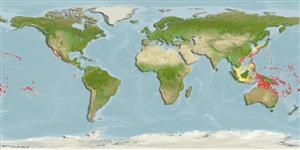Environment: milieu / climate zone / depth range / distribution range
Ecologia
marinhas associadas(os) a recifes; intervalo de profundidade 0 - 64 m (Ref. 27370), usually 0 - 40 m (Ref. 37816). Tropical
Pacific Ocean: southern Japan to New Caledonia, Hawaii and Pitcairn.
Tamanho / Peso / Idade
Maturity: Lm ? range ? - ? cm
Max length : 23.0 cm SL macho/indeterminado; (Ref. 27370); common length : 15.0 cm TL macho/indeterminado; (Ref. 9137)
Espinhos dorsais (total) : 11; Raios dorsais (total) : 14; Espinhos anais: 4; Raios anais : 9 - 11. Body with alternate red and yellow stripes dorsally, and with red and silvery white on side; ventrally, the yellow stripes often as a series of close-set spots, one per scale; head red, an oblique silvery white streak below eye and a vertical one on edge of preopercle; spinous dorsal fin yellow with narrow red margin; white caudal fin with a submarginal red band in each lobe, converging and broadening basally. Five oblique rows of scales on cheek. Body depth 2.5-2.85 in SL; head length 2.6-2.95 in SL; snout length 3.4-3.9 in head length; interorbital width 5.3-6.0 in head length; slightly projecting lower jaw. Maxilla either extending slightly beyond a vertical at front edge of pupil or reaching below center of eye; upper jaw length 2.3-2.65 in head length; premaxillary groove extending to or slightly posterior to a vertical at anterior edge of orbit; anterior end of nasal bone rounded; medial margin of nasal bone without spinule; edge of nasal fossa with 1 to 7 spinules; upper edge of suborbital bones below anterior half of eye without a spine or serrae (below posterior half weakly serrated); preopercular spine about 2/3 times in orbit diameter, 4.3-5.3 in head length; 1st and 2nd dorsal spine subequal, usually the 3rd is the longest, 2.15-2.7 in head length; 3rd anal spine 1.55-1.75 in head length. Usually 10 anal soft rays (Ref. 27370).
Inhabits deep reefs (Ref. 27370). Benthopelagic in or near crevices and caves (Ref. 58302). Feeds on small fishes and crustaceans (Ref. 89972).
Ciclo de vida ou comportamento de acasalamento
Maturidade | Reprodução | Desova | Ovos | Fecundidade | Larvas
Randall, J.E., 1998. Revision of the Indo-Pacific squirrelfishes (Beryciformes: Holocentridae: Holocentrinae) of the genus Sargocentron, with descriptions of four new species. Indo-Pac. Fish. (27):105 p. (Ref. 27370)
Status na Lista Vermelha da UICN (Ref. 130435: Version 2024-2)
Ameaça para os humanos
Harmless
Uso pelos humanos
Pescarias: espécies comerciais
Ferramentas
Relatórios especiais
Baixar XML
Fontes da internet
Estimates based on models
Preferred temperature (Ref.
123201): 24.4 - 29, mean 27.4 °C (based on 618 cells).
Índice de diversidade filogenética (Ref.
82804): PD
50 = 0.5000 [Uniqueness, from 0.5 = low to 2.0 = high].
Bayesian length-weight: a=0.01660 (0.00788 - 0.03495), b=2.97 (2.80 - 3.14), in cm total length, based on LWR estimates for this Genus-body shape (Ref.
93245).
Nível Trófico (Ref.
69278): 4.0 ±0.67 se; based on food items.
Resiliência (Ref.
120179): Elevada, tempo mínimo de duplicação da população menor que 15 meses (Preliminary K or Fecundity.).
Fishing Vulnerability (Ref.
59153): Low vulnerability (18 of 100).
Nutrients (Ref.
124155): Calcium = 53.8 [20.8, 214.3] mg/100g; Iron = 0.49 [0.19, 1.48] mg/100g; Protein = 18.7 [17.5, 19.9] %; Omega3 = 0.163 [0.071, 0.372] g/100g; Selenium = 32.2 [18.8, 62.8] μg/100g; VitaminA = 89.4 [34.6, 246.8] μg/100g; Zinc = 1.67 [0.69, 3.14] mg/100g (wet weight);
